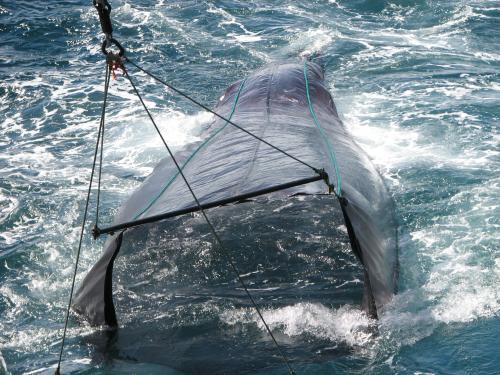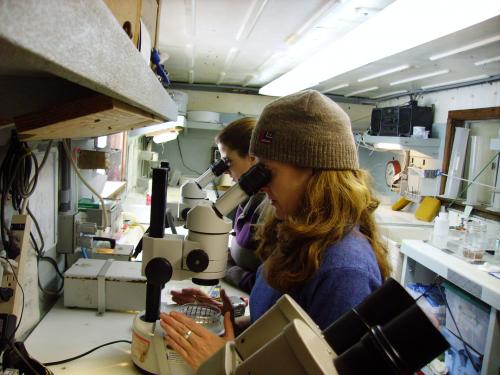It’s All About the Krill
There are 19 scientists on board the Yuzhmorgeologiya and we’re all dedicated to studying Antarctic krill (Euphausia superba) and their ecosystem.
I am on the zooplankton (the ocean’s small, drifting animal life) team and collectively we work 24 hours a day, 7 days a week sampling krill using an IKMT (Isaacs-Kidd Midwater Trawl) zooplankton net. We deploy the net off the back of the boat at designated stations and when the net comes up, we sort, identify, count and measure the krill as well as all the other zooplankton critters. We work in 12-hour shifts; I work the 8pm – 8am shift, and as you can imagine, that took a few days to get used to.

IKMT zooplankton net entering the water for sampling off the back of the vessel.
Photo by Lara Asato
Other teams on board sample for phytoplankton (tiny photosynthetic organisms drifting in the ocean), the primary food source for krill. Others spend their day watching for birds and mammals, the krill predators. Others study acoustics, which provide information about krill aggregations and biomass. We also deploy a CTD (Conductivity, Temperature and Depth) profiler to collect data on oceanographic variables, such as temperature and salinity. All of this is to get an understanding of the krill’s ecosystem and how that ecosystem drives their distribution and abundance.

Krill, (Euphausia superba) in a sorting dish after being hauled aboard in a zooplankton sampling net.
Photo by Lara Asato
And why do we care so much about krill to have a whole team of scientists dedicated to studying them? AMLR’s krill expert Dr. Valerie Loeb explains: “The whole ecosystem depends on krill. They are large shrimp-like crustaceans that form schools and abound in great numbers. Krill are a keystone species because they directly transfer primary productivity to energy in the system.” A host of predators depend on krill, including penguins, seabirds, fish, seals, as well as residential and migratory populations of whales.
Krill are also harvested by humans. In fact, a few days ago, we saw three krill fishing vessels in the South Orkneys. The vessels were from Norway, Poland and Korea – evidence of this valuable international fishery. In the past, krill was primarily used as bait and as fish meal in terrestrial and aquaculture farms. Nowadays it is also harvested for direct human consumption and for pharmaceutical products, including omega-3 fatty acid supplements.

Darci Lombard and I count the microscopic portions of the zooplankton sample. Every zooplankton tow has inverts we can pick out with tweezers and count. Then there is the “small portion” of microscopic organisms which we subsample and count.
Photo by Mitch Meredith
Krill biomass estimated from our survey will be used by CCAMLR to set appropriate fishing quotas. Additionally, because AMLR has over 20 years of survey data, we can tease out environmental- versus human-induced change in krill distribution and abundance. This is of interest to CCAMLR because humans are in direct competition with krill predators. Our data helps them in their goal of allowing rational harvesting without harming the Antarctic ecosystem.













Hi Cass! You rock! I hope you’re having a great time out there. I’m looking forward to reading your future posts! Say hi to the penguins for me.
Best,
Diane
Dear Diane,
Your rock too!!! Antarctica is such an amazing place… I said hi to all the penguins for you.
Best,
Cassandra
Hey Cassandra, love your article!
I’ve been working my first season on Steve’s Whale One, watching the beautiful Humpback as they play in our warm waters off Mooloolaba. We have been experiencing all the behavours, seen many young calves and even the competitive play of males/female. The more I view, the more I learn about these majestic mammals. Being in warmer waters we don’t get to experience the feeding, so I thank you for your efforts to educate us with their feeding behavours and keeping us up to date. We can read a book that was written in the 80’s, or a study posted in 2001- But reading direct from a present source is a clearer understanding.
I’ve been at Australia Zoo for 5 years now and with my position so open I am able to work closely with many groups of animals like Koalas, Aldabran Tortiose, Asian small clawed Otter, Snakes and some Birds. I have been trained to handle all and also talk about them in demos around the zoo, as well as in the Crocoseum. My latest adventure is the whale boat which the zoo owns, I’m on during the whale season and then back at zoo eagerly awaiting the next migration.
If I am able to get any more info from you on the Humpback, Krill, Orca and current conditions it would be very much appreciated. As I talk and educate on board this would all go toward the conservation message.
Love your work and passion,
Smooth sailing……
Jez
Hi Jez,
Thanks for your wonderful message! Sounds like you do incredible work and have terrific adventures yourself. I do not actually work on oceanography myself or mammals, but many scientists do. You could try to google and contact Jarrod Santora or Michael Force regarding any whale questions or Val Loeb regarding krill or oceanography. They are wealths of information!
Thanks again and best wishes,
Cassandra
Hey
My name is Brooke, I’m doing a project in school and I need interesting facts about the krill. I was wondering if you could help me. Thanks so much. By the way your article is really good. What your doing out there sounds like fun. Thanks again.
~Brooke~
Hi Brooke,
Krill isn’t my specialty, but I know a lot of folks who study the kritters. I suggest you get in touch with Val Loeb at Moss Landing Marine Labs (just google her name). Good luck!
-Cassandra